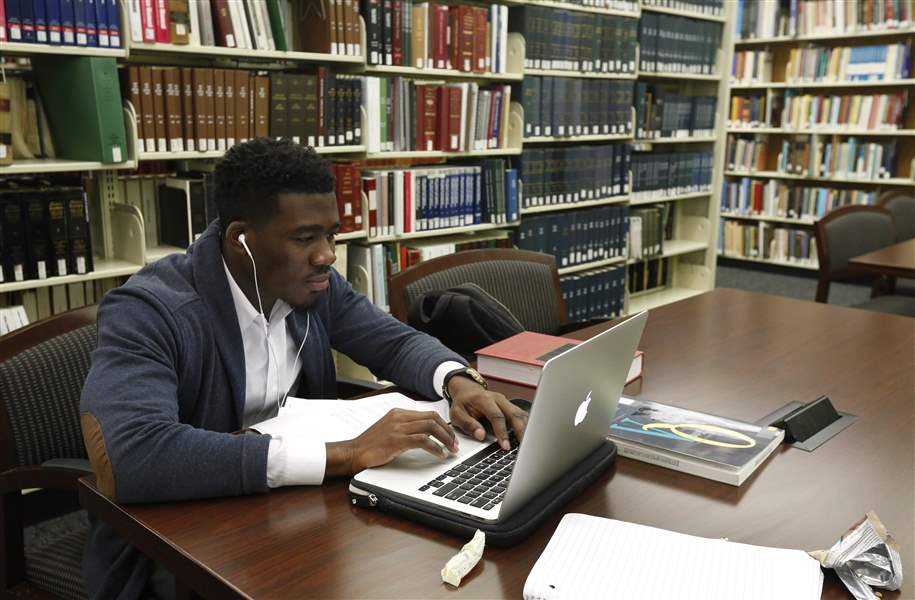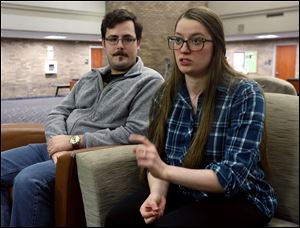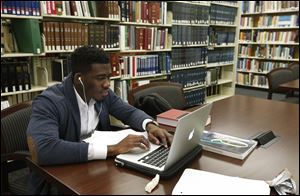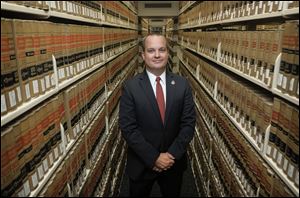
UT aims to boost law school performance
11/24/2017
Law student Muheez Afolabi studies in one of the libraries at the University of Toledo Law Center in Toledo.
The Blade/Lori King
Buy This Image
As the University of Toledo continues to sit in the bottom half of Ohio’s nine law schools, administrators have watched two accredited law schools shutter and a third announce it will stop admitting new students.
Law schools across the country are struggling to rebound from an economic downturn that slashed job opportunities for graduates and depleted enrollment numbers, and 2017 is the first time institutions accredited by the American Bar Association have shut their doors.
California’s Whittier Law School was the first to close in April, with Charlotte School of Law in North Carolina following suit in August. Just this month, Valparaiso Law School suspended admissions.
“It’s been a tough seven years for law schools nationwide,” said Ben Barros, dean of UT’s College of Law.
The numbers show the past decade has been a difficult one for UT’s College of Law.
VIDEO: Jake and Amanda Westfall
The rate at which UT graduates pass the July bar exam on their first try fell from a high of 90 percent in 2008 to a dismal 63 percent in 2016, and the overall pass-rate mirrored the trend, slipping from 85 percent to 59 percent during the same period.

Jake and Amanda Westfall talk about their choice to attend law school at the University of Toledo Law Center in Toledo.
Enrollment also plummeted, from 496 in 2008 to just 228 in 2016.
“People view law school as a ticket to financial security, and frankly, it’s not today,” said Kyle McEntee, executive director of advocacy group Law School Transparency. “That’s why we’re seeing enrollment dropping across the country over the last five years.”
But Mr. Barros, who took over as dean in 2015, is working to prevent UT from becoming the next law school to face closure. He is pushing for higher enrollment by offering scholarships while simultaneously raising admission requirements. He has also implemented programs to help lower performing students prepare for the bar exam.
And 2017 already shows improvement: The first-time passage rate jumped 11 percentage points — from 63 percent last year to 74 percent in July 2017 — and enrollment saw its first increase in years, from 228 to 247.
But UT is still a long way from the days of 90 percent bar passage rates.
“Once you take the bar for granted, it will come up and bite you in the butt,” Mr. Barros said. “That’s what happened with us. We were doing really well, and we took it for granted, and it takes a couple years to get your program back together again.”
An affordable choice
Second-year law students Jake and Amanda Westfall, both 23, said they chose UT for the value. Tuition and fees for Ohio, Michigan, or Indiana residents is $19,973 per semester and $31,522 for students who come to Toledo from outside of those three states.
Scholarships and stipends allow them to pursue their juris doctor degrees nearly free of charge, making Toledo the best choice for their pocketbooks.
But the Cleveland-area couple wasn’t expecting so many of their UT professors to hail from top-tier institutions, as the law school is tied at No. 132 on the latest U.S. News and World Report.
“When we got here and were able to see the professors and their credentials, I was surprised at the caliber of the faculty,” Mr. Westfall said.

Law student Muheez Afolabi studies in one of the libraries at the University of Toledo Law Center in Toledo.
Of the law school’s 25 full-time faculty, 44 percent graduated from institutions rated as the top 15 in the country. They include two alumni from top-ranked Yale University, two from No. 3-ranked Harvard University, and one from Columbia University, ranked fifth. Those credentials reassured Mr. Westfall that he and his wife made the right choice, he said.
Mr. Westfall acknowledged that attending a top-tier law school increases one’s chances to land a job at larger, more prestigious firms, but he said what really matters is how good you are at practicing law.
“If you want to be a Supreme Court justice, then maybe that’s the case, but just for being a lawyer, a law degree from anywhere will do the job,” he said.
Second-year law student and Whitmer High School graduate Ben Syroka, 25, knew from an early age he wanted to practice law.
He studied history with a concentration in law for his undergraduate degree and fared well on the Law School Admission Test in 2015, scoring a 166, which was in the 93rd percentile. When it came time to pick a law school, he said he chose UT because of its affordability.
“My GPA and my LSAT score put me in a position where I could apply to some larger, more prestigious institutions,” Mr. Syroka said. “But you look at where you want to live and where you want to practice, and you look at, ‘Is your amount of debt going to allow you to do that?’”
The average overall student debt for a UT law student this year is $81,626, Mr. Barros said. That’s down from an average of $99,000 in 2013, and much of that can be attributed to an increase in scholarships as law schools compete to attract students from a smaller pool of applicants.
UT’s scholarship budget is about $3.5 million, which includes about $350,000 of endowed scholarships held by the UT Foundation, Mr. Barros said. Giving out more scholarship money can lead to increased tuition revenue, if it successfully brings in students who would have otherwise enrolled elsewhere.
But enticing students to apply in the first place relies on high bar passage rates and strong post-graduation employment numbers. American Bar Association data shows just 36 percent of UT’s class of 2016 were employed 10 months after graduation in full-time jobs that required them to pass the bar.
“The numbers pretty much speak for themselves,” Mr. McEntee said. “Even at a more affordable school, it’s still an expensive endeavor, and the odds of getting a job are not great, and the odds of passing the bar are slightly below average.”
But both the Westfalls and Mr. Syroka said they’re confident they’ll be able to pass the bar on their first go, and they don’t have any qualms about their job prospects, either.
“As accessible as the professors are here, and as willing to help as they are, if a student leaves this school and isn’t prepared to pass the bar, it’s their own fault,” Mr. Westfall said.
Toledo attorney Chris Parker, a 1984 UT graduate and past president of the Toledo Bar Association, talks often with first-year UT law students. He said he is candid about the tough job market because he doesn’t want to give them “a false sense of security,” but he believes their education at his alma mater is valuable.
“I think Toledo is better served because it has a law school, and I think the legal community is better served by having the law school here,” he said.
Mr. McEntee contends that nine law schools in one state is just too many, and it adds to the bloated number of law school graduates jostling for fewer jobs.
He believes that in order for UT and other Ohio law schools to survive, they should merge and form one central law school with satellite institutions throughout the state for second- and third-year students.

University of Toledo College of Law Dean Ben Barros
Raising the bar
Even as UT saw its first-time bar passage rate improve and enrollment tick up this year, leaders acknowledge they need to do better.
UT President Sharon Gaber has made growing the university’s academic rankings and boosting its overall reputation a priority, and she said she wants to give Mr. Barros the chance to route the law school back in the right direction.
“If we continue to see enrollment and bar passage rate not make improvement, we’ll look at that, because I continue to look at everything that we’re doing,” Ms. Gaber said. “The all-time [bar] passage rate, that wasn’t a great rate. Yet I know that Dean Barros has said we’re going to keep making progress and work on that and improve.”
In the last two years, Mr. Barros has implemented new initiatives to combat the low bar passage rates, both for first-time test takers and for those who take it multiple times, and he’s hopeful the improvements will translate to more graduates finding better employment.
“You go to law school to get a job, and we take that really seriously,” Mr. Barros said. “Unfortunately, having a bar pass issue becomes one of those overwhelming things that we have to get sorted out before we can do anything else.”
Most law school graduates enroll in private bar preparation courses between the time they graduate in May to when they sit for the exam in July. Graduates who don’t complete those classes typically don’t do as well on the exams as those who do, so the college added a new third-year course to help students prepare for the exam before they graduate.
“You can’t not do it,” legal writing professor Lesa Byrnes said. “There’s too much at stake.”
Ms. Byrnes also serves as the college’s director of bar preparation and academic success, a position Mr. Barros created to help track students who need academic help. She teaches a workshop for students in their first semester to learn how to better study, write outlines, and take exams.
She also instituted a rule that any student with a 2.7 GPA or below must meet with her and develop a plan to raise their grades before they’re allowed to register for their next semester of classes. It ensures students enroll in courses they’ll be tested on when they take the bar exam, rather than settling for easier electives, she said.
“It also gives me the opportunity for face-to-face time with them, and I really have developed relationships with these students,” Ms. Byrnes said.
The law school is also increasing support for graduates. Each student is now paired with a faculty mentor in the 12 weeks between when they graduate and when they sit for the bar exam, who pushes them to complete a bar preparation course.
Mr. Barros is hopeful that providing academic support for students from their first semester, through their third year, and after graduation will help move the needle. But he said being more selective on students who are admitted to the program needs to happen as well. He’d like to see all incoming students score a 150 on their LSAT, because students who score below that threshold typically have a harder time passing the bar, he said.
That being said, he’d also like to see enrollment grow from the latest entering class of 92 to an average entering class of 120 to keep the law school a financially healthy arm of the university.
And he also wants to continue the university’s mission of providing education to first-generation college students who may need extra help, and offering a part-time, evening law school option for those who need to work while in school.
“There’s a large percentage of our students now, and historically, that are Toledo kids who would not have gone elsewhere,” Mr. Barros said.
President Gaber stressed the importance of being a “comprehensive research university,” and a robust law school is part of that mission.
“Each one of these things is a piece in the puzzle,” Mr. Barros said. “If we do 20 different things all better, that’s where we’ll start seeing the results.”
Contact Sarah Elms at selms@theblade.com, 419-724-6103, or on Twitter @BySarahElms.